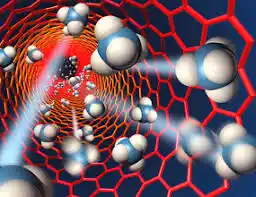افشین رشید
اُستادیار ؛ عضو هیات علمی دانشگاه آزاد اسلامی واحد علوم و تحقیقات تهران
618 یادداشت منتشر شدهThe Process of Thermal instability (Nanoparticles) in the change structure, the structure and structure of Nanomaterials

Note: All atoms in nanomaterials at any temperature allocate a certain amount of energy due to their fluctuations. The amplitude of this oscillation is not the same in all the atoms of the nanomaterial. Moreover, the surface atoms have a larger range of oscillation due to the greater spatial freedom they have. In this way, the strange behavior of solids in reducing their melting temperature can be explained.
When the average value of the atomic vibration range reaches a certain coefficient of the constant value of the nanomaterial network, these vibrations can no longer increase without damaging and destroying the nanoparticle network. Therefore, by increasing the average range of vibrations to larger values, the material is removed from the crystal lattice and melts. Surface atoms have higher average fluctuations and if the number of surface atoms increases, they can have a clear effect on the average range of fluctuations of all atoms of the material. Therefore, as the dimensions of the material shrink until the ratio of the number of surface atoms to the number of volume atoms reaches a significant value, the average range of nanomolecular oscillations will increase significantly; In this situation, with the increase of surface instability of the material, the melting temperature of nano materials will decrease.

In changing the structure of nanomaterials, one of the thermal phenomena caused by the shrinking of the material structure is the thermal instability of nanoparticles. As you know, heat has energy E, which 03- its energy amount is proportional to the temperature of the environment. This energy is equal to KBT. In this relationship, KB is Boltermann's constant and a constant value equal to and T is the temperature in Kelvin. Therefore, when materials are placed in different environments, due to heat, electrons are given energy (JK-0.01*0.33). Now consider a property of a particle that generally depends on (the volume of the nanoparticle V). The energy of this feature is U and a function of V. When the volume is small enough, such that KBT is greater than U, then the condition will be thermally unstable.
Conclusion :
All the atoms in nanomaterials at any temperature allocate a certain amount of energy due to their fluctuations. The amplitude of this oscillation is not the same in all the atoms of the nanomaterial. Moreover, the surface atoms have a larger range of oscillation due to the greater spatial freedom they have. In this way, the strange behavior of solids in reducing their melting temperature can be explained.